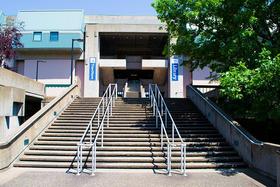- Northeast Texas Community College is a public community college near Mount Pleasant, Texas.
School Highlights
Northeast Texas Community College serves 4,033 students (33% of students are full-time).
The college's student-teacher ratio of 16:1 is lower than the state community college average of 23:1.
Minority enrollment is 52% of the student body (majority Hispanic), which is less than the state average of 74%.
Quick Facts (2025-26)
- Enrollment: 4,033 students
- In-state tuition: $2,999
- Out-state tuition: $4,113
- Student-teacher ratio: 16:1
- Minority enrollment: 52%
- Source: Integrated Postsecondary Education Data System (IPEDS)
School Overview
The teacher population of 255 teachers has stayed relatively flat over five years.
Northeast Texas Community College
(TX) Community College Avg.
Carnegie Classification
Associate's Colleges: Mixed Transfer/Career & Technical-Mixed Traditional/Nontraditional
Baccalaureate/Associate's Colleges: Associate's Dominant
Institution Level
At least 2 but less than 4 years
At least 2 but less than 4 years
Institution Control
Public
Public
Total Faculty
255 staff
262 staff
School Calendar
Student Body
The student population of Northeast Texas Community College has grown by 34% over five years.
The student-teacher ratio of 16:1 has increased from 11:1 over five years.
The Northeast Texas Community College diversity score of 0.65 is less than the state average of 0.70. The school's diversity has stayed relatively flat over five years.
Total Enrollment
4,033 students
4,931 students
Student-Teacher Ratio
16:1
23:1
# Full-Time Students
1,343 students
909 students
# Part-Time Students
2,690 students
4,022 students
# Enrollment Undergraduate
403 students
403 students
# Full-Time Undergraduate Students
1,343 students
890 students
# Full-Time Graduate Students
n/a
40 students
# Part-Time Undergraduate Students
2,690 students
4,166 students
# Part-Time Graduate Students
n/a
47 students
Total Dormitory Capacity
220 students
252 students
% American Indian/Alaskan
n/a
n/a
% Asian
2%
6%
% Hispanic
33%
46%
% Black
11%
13%
% White
48%
26%
% Hawaiian
n/a
n/a
% Two or more races
2%
3%
% Non Resident races
2%
2%
% Unknown races
n/a
4%
Diversity Score
0.65
0.70
College Completion Rate (Students who graduate in less than 4 years)
34%
55%
College Completion Rate (Students who graduate in 4 years or more than 4 years)
n/a
34%
Average Graduate Earnings (10 Years)
$31,500
$34,600
Tuition and Acceptance Rate
The public in-state tuition of $2,999 is less than the state average of $3,764. The in-state tuition has declined by 40% over four years.
The public out-state tuition of $4,113 is less than the state average of $6,054. The out-state tuition has declined by 36% over four years.
In-State Tuition Fees
$2,999
$3,764
Out-State Tuition Fees
$4,113
$6,054
% Students Receiving Some Financial Aid
87%
84%
Median Debt for Graduates
$10,500
$10,765
Median Debt for Dropouts
$7,125
$5,500
Acceptance Rate
n/a
84%
Sports
Total Sports Offered
3 sports
Sports
BaseballSoccer
Softball
Source: 2024 (or latest year available) Integrated Postsecondary Education Data System (IPEDS)
Frequently Asked Questions
How much does Northeast Texas Community College cost?
Northeast Texas Community College's tuition is approximately $2,999 for In-State students and $4,113 for Out-State students.
What sports does Northeast Texas Community College offer?
Northeast Texas Community College offers 3 interscholastic sports: Baseball, Soccer and Softball.
Recent Articles

The Rise of Technical and Vocational Training in 2025
Explore the 2025 surge in technical and vocational training—enrollment, policy, costs, and why this path is gaining ground for students and parents.

Stackable Credentials: How Community Colleges Advance Careers
Discover how community colleges use stackable credentials to build career pathways, boost earnings, and enable lifelong learning in 2025.

High-Paying Jobs You Can Get with a Community College Degree
Discover top high-paying careers you can launch in 2025 with a community college (associate) degree and high-growth credentials in tech, healthcare and trades.









